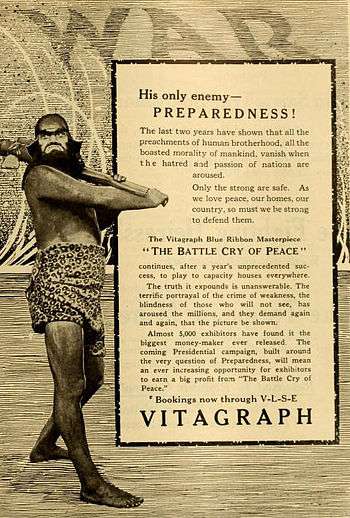The Battle Cry of Peace
The Battle Cry of Peace is a 1915 American silent war drama film directed by Wilfrid North and J. Stuart Blackton, one of the founders of Vitagraph Company of America who also wrote the scenario. The film is based on the book Defenseless America, by Hudson Maxim, and was distributed by V-L-S-E, Incorporated. The film stars Charles Richman, L. Rogers Lytton, and James W. Morrison.[2]
| The Battle Cry of Peace | |
|---|---|
 | |
| Directed by | Wilfrid North J. Stuart Blackton |
| Written by | J. Stuart Blackton (scenario) |
| Based on | Defenseless America by Hudson Maxim |
| Music by | S. L. Rothapfel S. M. Berg Ivan Rudisill |
| Cinematography | Leonard Smith Arthur T. Quinn |
Production company | Vitagraph Company of America |
| Distributed by | V-L-S-E, Incorporated |
Release date |
|
Running time | 90 minutes |
| Country | United States |
| Language | Silent English intertitles |

Alternate titles for this film were A Call to Arms and The Battle Cry of War. In the UK, the film was called An American Home. A sequel followed in 1917, Womanhood, the Glory of the Nation.
Plot
In a war-torn world, enemies of the United States use pacifists as pawns to make sure that the United States does not spend too much on defense. Then the enemies attack and take over the country.
Significance
Upon its release, the film generated a controversy rivaling that of Birth of a Nation because it was considered to be militaristic propaganda. Producer Stuart Blackton believed that the US should join the Allies involved in World War I overseas, and that was why he made the film. Former President Theodore Roosevelt was one of the film's staunchest supporters, and he persuaded Gen. Leonard Wood to lend Blackton an entire regiment of Marines to use as extras.[3]
Cast
- Charles Richman - John Harrison
- L. Rogers Lytton - Mr. Emanon
- James W. Morrison - Charley Harrison
- Mary Maurice - Mrs. Harrison
- Louise Beaudet - Mrs. Vandergriff
- Harold Hubert - John Vandergriff
- Jack Crawford - Poet Scout
- Charles Kent - The Master
- Julia Swayne Gordon - Magdalen
- Belle Bruce - Alice Harrison
- Norma Talmadge - Virginia Vandergriff
- Lucille Hammill - Dorothy Vandergriff
- Evart Overton - Vandergriff's son
- George Stevens - Butler
- Thais Lawton - Columbia
- Lionel Braham - The War Monster
- William J. Ferguson - Abraham Lincoln
- Paul Scardon - Ulysses S. Grant
- Joseph Kilgour - George Washington
Status
The majority of the film is now considered lost.[4] The Cinemateket-Svenska Filminstitutet possesses one reel.[5] Fragments of footage of battle scenes survive and are housed at the George Eastman House.[5][6]
References
- Slide, Anthony (1976). The Big V: A History of the Vitagraph Company. Metuchen, N.J.: Scarecrow Press. p. 77. ISBN 9780810809673.
- Moving Picture Exhibitors' Association (1915). The Moving Picture World, Volume 25, Issues 4-6. Chalmers Publishing Company. p. 795.
- Magill's Survey of Silent Films, Vol.l A-FLA p.175 edited by Frank N. Magill c.1982 ISBN 0-89356-240-8 (3 book set ISBN 0-89356-239-4) Retrieved December 11, 2014
- "The Battle Cry of Peace". Retrieved July 19, 2018.
- Greta de Groat (Electronic Media Cataloger at Stanford University Libraries). "The Feature films [sic] of Norma Talmadge".
- The Battle Cry of Peace at silentera.com